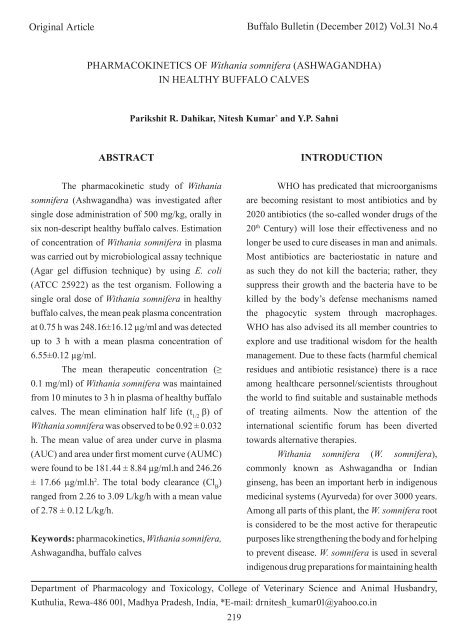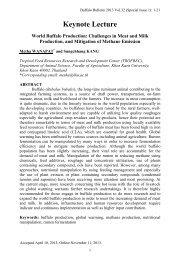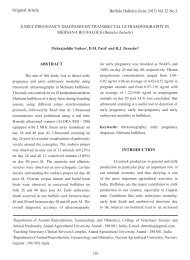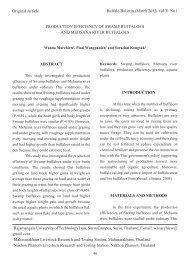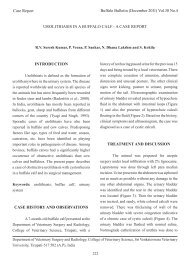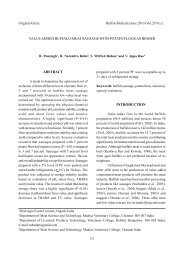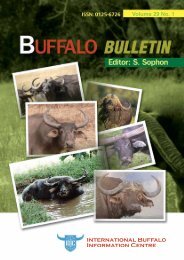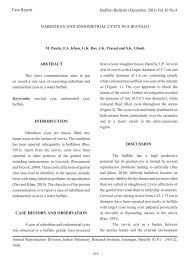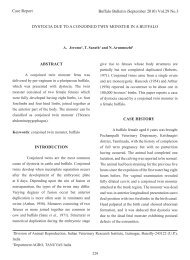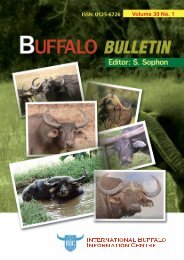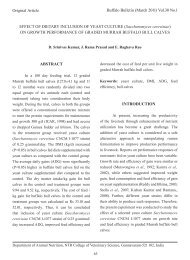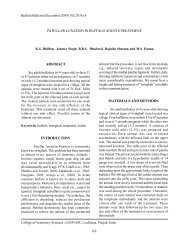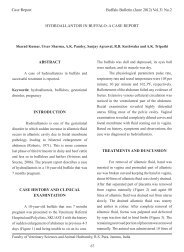PHARMACOKINETICS OF Withania somnifera (ASHWAGANDHA ...
PHARMACOKINETICS OF Withania somnifera (ASHWAGANDHA ...
PHARMACOKINETICS OF Withania somnifera (ASHWAGANDHA ...
You also want an ePaper? Increase the reach of your titles
YUMPU automatically turns print PDFs into web optimized ePapers that Google loves.
Original ArticleBuffalo Bulletin (December 2012) Vol.31 No.4<strong>PHARMACOKINETICS</strong> <strong>OF</strong> <strong>Withania</strong> <strong>somnifera</strong> (<strong>ASHWAGANDHA</strong>)IN HEALTHY BUFFALO CALVESParikshit R. Dahikar, Nitesh Kumar * and Y.P. SahniABSTRACTINTRODUCTIONThe pharmacokinetic study of <strong>Withania</strong><strong>somnifera</strong> (Ashwagandha) was investigated aftersingle dose administration of 500 mg/kg, orally insix non-descript healthy buffalo calves. Estimationof concentration of <strong>Withania</strong> <strong>somnifera</strong> in plasmawas carried out by microbiological assay technique(Agar gel diffusion technique) by using E. coli(ATCC 25922) as the test organism. Following asingle oral dose of <strong>Withania</strong> <strong>somnifera</strong> in healthybuffalo calves, the mean peak plasma concentrationat 0.75 h was 248.16±16.12 μg/ml and was detectedup to 3 h with a mean plasma concentration of6.55±0.12 μg/ml.The mean therapeutic concentration (≥0.1 mg/ml) of <strong>Withania</strong> <strong>somnifera</strong> was maintainedfrom 10 minutes to 3 h in plasma of healthy buffalocalves. The mean elimination half life (t 1/2β) of<strong>Withania</strong> <strong>somnifera</strong> was observed to be 0.92 ± 0.032h. The mean value of area under curve in plasma(AUC) and area under first moment curve (AUMC)were found to be 181.44 ± 8.84 μg/ml.h and 246.26± 17.66 μg/ml.h 2 . The total body clearance (Cl B)ranged from 2.26 to 3.09 L/kg/h with a mean valueof 2.78 ± 0.12 L/kg/h.Keywords: pharmacokinetics, <strong>Withania</strong> <strong>somnifera</strong>,Ashwagandha, buffalo calvesWHO has predicated that microorganismsare becoming resistant to most antibiotics and by2020 antibiotics (the so-called wonder drugs of the20 th Century) will lose their effectiveness and nolonger be used to cure diseases in man and animals.Most antibiotics are bacteriostatic in nature andas such they do not kill the bacteria; rather, theysuppress their growth and the bacteria have to bekilled by the body’s defense mechanisms namedthe phagocytic system through macrophages.WHO has also advised its all member countries toexplore and use traditional wisdom for the healthmanagement. Due to these facts (harmful chemicalresidues and antibiotic resistance) there is a raceamong healthcare personnel/scientists throughoutthe world to find suitable and sustainable methodsof treating ailments. Now the attention of theinternational scientific forum has been divertedtowards alternative therapies.<strong>Withania</strong> <strong>somnifera</strong> (W. <strong>somnifera</strong>),commonly known as Ashwagandha or Indianginseng, has been an important herb in indigenousmedicinal systems (Ayurveda) for over 3000 years.Among all parts of this plant, the W. <strong>somnifera</strong> rootis considered to be the most active for therapeuticpurposes like strengthening the body and for helpingto prevent disease. W. <strong>somnifera</strong> is used in severalindigenous drug preparations for maintaining healthDepartment of Pharmacology and Toxicology, College of Veterinary Science and Animal Husbandry,Kuthulia, Rewa-486 001, Madhya Pradesh, India, *E-mail: drnitesh_kumar01@yahoo.co.in219
Buffalo Bulletin (December 2012) Vol.31 No.4as well as treatment of several disease conditions.Its main use is as an immunomodulator and as anantistressor. The roots of W. <strong>somnifera</strong> containseveral alkaloids, withanolides, a few flavanoidesand reducing sugars. W. <strong>somnifera</strong> containsnumber of phytoconstituents, withanolides as themajor constituent. It is one of the most commonlyused drugs as a natural antimicrobial agent (Jafferand Jawad, 1998). W. <strong>somnifera</strong> commonly usedIndian medicinal plant for antimicrobial activitysince the ancient time. The antibacterial activityof W. <strong>somnifera</strong> is now approaching for evaluationof its therapeutic efficacy and valuable use asan antibacterial agent in the present study. Itstherapeutic use should be based on the correlationbetween antibacterial activity and its concentrationachieved in vivo. Among various factors thatdetermine the variation in intensity and durationof pharmacological effects, dosage, route ofadministration and disease status of animal are ofmuch importance.The majority of the population, particularlythose living in villages, depends largely on herbalmedicine. Scientific data on a good number ofmedicinal plants investigated is well documented.However, only very few drugs of plant origin havereached clinical use and the National Formularycould not adopt even a dozen plant medicines.For this reason, a special effort is needed fordevelopment of herbal drugs having therapeuticutility.There is no data available for the kineticstudy of W. <strong>somnifera</strong> in any species of animal so far.Therefore, the study was conducted in expectationto enhance to a remarkable extent the use of W.<strong>somnifera</strong> judiciously in animal practices, and alsoto consider species variations due to differences inpharmacokinetics of antibacterial agents. Hence,the present study was undertaken, to investigatethe pharmacokinetics of W. <strong>somnifera</strong> in healthybuffalo calves.MATERIALS AND METHODSSix clinically healthy male buffalo calvesof non-descript breed between 6 to 8 months ofage and 100-150 kg body weight were used. Theexperiment was approved by the institute ethicalcommittee and the synopsis committee of MadhyaPradesh Pashu Chikitsa Vigyan Vishwavidyalaya,Jabalpur, Madhya Pradesh, India as a part of postgraduate degree programme of the first author.These buffalo calves were housed in an animal shedand maintained on dry fodder and greens as wellas routine grazing for at least 4-5 h a day. Cleandrinking water was available ad libitum.The roots of W. <strong>somnifera</strong> were obtainedfrom the Department of Aromatic and MedicinalPlants, Agriculture College, J.N.K.V.V., Jabalpur.The roots of W. <strong>somnifera</strong> were shed dried andcrushed in a mixer and grinder to prepare a finepowder. 100 g of W. <strong>somnifera</strong> powder wasdissolved in 1 L of sterile triple distilled water for24 h to make a cold aqueous extract of W. <strong>somnifera</strong>.The cold aqueous extract of W. <strong>somnifera</strong> wasadministered at a dose rate of 500 mg /kg bodywt. orally by drenching tube in each of the sixhealthy buffalo calves. Before collection of blood,the sites around the jugular vein on either site ofthe neck of the animals were aseptically prepared.The sites were sterilized prior to each collectionwith rectified spirit. Blood samples (approx.1 ml) were withdrawn from jugular vein intoheparinized glass centrifuge tubes at 0, 10, 15, 20,30, 45 minutes and 1, 1.5, 2, 2.5, 3, 4 and 6 h afteradministration of the drug. Plasma was separatedby centrifugation at 3,000 r.p.m. for 15 minutes at220
Buffalo Bulletin (December 2012) Vol.31 No.4room temperature and kept at -4ºC until analysis.For preparation of standards, normal plasma priorto drug administration was also collected.Aqueous extract of W. <strong>somnifera</strong> wasprepared as 100 g of W. <strong>somnifera</strong> powder with 1L of sterile triple distilled water; after 24 h, thissolution was used for preparation of stock solutionof 100 mg/ml of W. <strong>somnifera</strong>. One millilitre ofstock solution (100 mg/ml) was dissolved in 1 mlof triple distilled water under constant stirring toobtain 50 mg/ml and also 50 mg/ml was dilutedin triple distilled water to make different strengthsviz., 25, 12.50, 6.25, 3.13, 1.56 and 0.78 mg/ml inwater. From each standard solution of W. <strong>somnifera</strong>in water, 50 μl was added to a centrifuge tubecontaining 450 μl of plasma collected prior to drugadministration. This yielded W. <strong>somnifera</strong> standardsof 10, 5, 2.5, 1.25, 0.625, 0.313, 0.156 and 0.078mg/ml in plasma. Blank plasma containing no W.<strong>somnifera</strong> was also prepared.The test organism used for themicrobiological assay technique (agar gel diffusiontechnique) of W. <strong>somnifera</strong> was E. coli (ATCC25922). The organism was grown on the slant ofculture tube containing nutrient agar slants at 37 o Cfor overnight. Then it was stored under refrigeration.The organism was transferred weekly to freshmedia to maintain its normal activity (Arora et al.,2004).Pharmacokinetic analysis of W. <strong>somnifera</strong>after single oral administration was calculated froma semi-logarithmic scale as a plot of plasma drugconcentration versus time curve. The log plasmadrug concentration versus time profile showed anon-linear curve and hence, non-compartmentalanalysis was done through statistical momentapproach as described by Singh (1999). Themean therapeutic concentration (≥ 0.1 mg/ml) ofW. <strong>somnifera</strong> was maintained from 10 minutes to3 h in plasma of healthy buffalo calves as statedby Arora et al. (2004) who reported the minimuminhibitory concentration (MIC) of W. <strong>somnifera</strong>,which came out to be 0.1 mg/ml for S. typhimuriumand E. coli.RESULTS AND DISCUSSIONPlasma concentrations of W. <strong>somnifera</strong> atvarious time intervals following a single oral doseof 500 mg/kg in healthy buffalo calves are shownin Figure 1.The mean plasma concentration of the drugat 0.16 h was found to be 6.39 ± 0.11 mg/ml and thevalue ranged from 6.13 to 6.88 mg/ml. The drugwas detectable in all six animals up to 3 h with themean plasma concentration was 6.55 ± 0.12 mg/ml.The drug was not detectable in any of six animalsafter 4 h. The peak concentration of W. <strong>somnifera</strong>was found at 0.75 h with mean concentration of248.16 ± 16.12 mg/ml as shown in the Figure. 1.Plasma drug concentration versus timeprofile has shown non-linear curve. Hence, kineticparameters were derived from the formula of noncompartmentalanalysis through statistical momentapproach. The values of different kinetic parameterscalculated by the above noted non-compartmentalanalysis. The elimination rate constant (β) rangedfrom 0.67 to 0.82 h -1 with a mean value of 0.74± 0.025 h -1 . The mean elimination half life (t 1/2β)values of the drug were observed to be 0.92 ± 0.032h as shown in Table 1 .There is no data available for the kineticstudy of W. <strong>somnifera</strong> in any species of animal sofar; therefore, the kinetic parameters calculatedin the present study are discussed as follows:Plasma concentration of W. <strong>somnifera</strong> versustime disposition curves after oral administration221
Buffalo Bulletin (December 2012) Vol.31 No.4were best fit to non compartmental analysis in allsix buffalo calves, which is in accordance withresults reported for pharmacokinetics of oraladministration of sulphur mustard decontaminantCC-2 in rats (Lal et al., 2003).Following a single oral dose of W.<strong>somnifera</strong> in healthy buffalo calves, mean peakplasma concentration at 0.75 h was 248.16 ± 16.12mg/ml and was detected up to 3 h with a meanplasma concentration of 6.55 ± 0.12 mg/ml.Most of the kinetic parameters of W.<strong>somnifera</strong> (500 mg/kg, orally) as elimination rateconstant (β) was calculated 0.74 ± 0.025 h -1 whichsuggested that slightly faster rate of eliminationof W. <strong>somnifera</strong> when administered orally. Thisis best supported by elimination half-life (t 1/2β)which were noted 0.92 ± 0.032 h in healthy buffalocalves.The high values of AUC∞, AUMC∞ andMRT reflect that most of the body area is coveredwith the drug concentrations. The AUC∞ valuewas calculated 181.44 ± 8.84 mg/ml.h in healthybuffalo calves. Similar to this AUMC∞ value was246.26 ± 17.66 mg/ml.h 2 and MRT values 1.34 ±0.045 h were found. That clearly indicated that themaximum area covered by drug W. <strong>somnifera</strong> afterFigure 1. Plasma concentrations of W. <strong>somnifera</strong> following a single oral dose of 500 mg/kg in healthybuffalo calves.Table 1. Kinetic parameters of W. <strong>somnifera</strong> following a single oral administration of 500 mg/kg in healthycalves.Parameter (Unit)Mean ± S.E.M.β (h -1 ) 0.74 ± 0.025t 1/2β (h) 0.92 ± 0.032AUC∞ (mg/ml.h) 181.44 ± 8.84AUMC∞(mg/ml.h 2 ) 246.26±17.66MRT (h) 1.34 ± 0.045Vdss (L/kg) 3.68 ± 0.12Cl B(L/kg/h) 2.78 ± 0.12222
Buffalo Bulletin (December 2012) Vol.31 No.4oral administration in the body of buffalo calves.The relatively high value of Vd SS(3.68 ±0.12 L/kg) was observed in healthy buffalo calves.A large volume of distribution (>1 L/kg) indicateswide distribution throughout the body or extensivetissue binding or rapid excretion of a drug orcombination of all the above. A high value of Vd ssobtained in the present study showed the widedistribution of W. <strong>somnifera</strong> in the body of buffalocalves.The total body clearance (Cl B) value ofW. <strong>somnifera</strong> in healthy buffalo calves was 2.78± 0.12 L/kg/h which showed slightly increasedclearance from the body of buffalo calves, whichis in accordance with results of Cl B= 2.45 ± 0.21L/kg/h after oral administration of sulphur mustarddecontaminant CC-2 in rats (Lal et al., 2003).Herbs are the backbone of therapeuticstrategies. India, having huge wealth of plantbiodiversity, holds excellent potential for herbaltreatment. After evaluating the efficacy andpharmacokinetics of medicinal plants, extractswill be recommended for clinical trials in animalsunder controlled conditions. The ethano medicinaldata on indigenous plant W. <strong>somnifera</strong> will serveas useful tool to pharmacologists and clinicians fordevelopment of herbal preparations of indigenousplants. Pharmacokinetics of W. <strong>somnifera</strong> willprovide valuable clues to the clinician for its largescale use in future.antimicrobial activity of <strong>Withania</strong> <strong>somnifera</strong>extracts. Fitoterapia., 6: 497-500.Lal, J., V. Kumar and R.C. Gupta. 2003.Pharmacokinetics of oral and transdermaladministration of a sulphur mustarddecontaminant CC-2 in rats: A preliminarystudy. Indian J. Pharmacol., 35: 297-303.Singh, B. 1999. Non compartmentalpharmacokinrtic analysis of plasma leveldata through statistical moment approach:a worksheet distance, p. 36-40. In ICARshort course on “Recent Approach inClinical Pharmacokinetic and TherapeuticMonitoring of Drugs in Farm Animals”.Oct 25-Nov 3. Division of Pharmacologyand Toxicology IVRI, Izzatnagar, India.REFERENCESArora, S., S. Dhillon, G. Rani and A. Nagpal.2004. The in vitro antibacterial/synergisticactivities of <strong>Withania</strong> <strong>somnifera</strong> extracts.Fitoterapia, 75(3-4): 385-388.Jaffer, H.J. and A.L.M. Jawad. 1998. Evaluation of223


